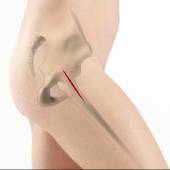
What is an Anterior Total Hip Replacement?
An anterior total hip replacement is a minimally invasive approach to a hip replacement that is performed through a 4inch incision over the front of the thigh. This approach is considered “intermuscular” meaning that the muscles overlying the hip joint are moved out of the way to enable the surgeon access to the hip capsule. With the traditional posterior or lateral approach to a hip replacement, muscles and tendons are actually split to perform the surgery, which can contribute to a limp post operatively.
This approach to hip replacements was developed for multiple reasons including accelerated rehabilitation, decreasing the risk of a hip dislocation and minimizing the possibility of a leg length discrepancy.
Which Patients Are Candidates for an Anterior Total Hip Replacement?
Most patients with osteoarthritis of the hip are candidates for this approach. Less ideal patients for the anterior approach are those with significant deformities of their proximal femur due to previous trauma or dysplasia and previous acetabular fractures. The procedure is available for all age groups. Only the surgeon can determine if a patient is a candidate for the procedure although the vast majority of patients are.
Anterior Total Hip Replacement Procedure
The surgery is performed either at an ambulatory surgery center in Nashville/Franklin or at one of the downtown hospitals in Nashville (St Thomas Midtown, Hospital for Special Surgery or TriStar Centennial). The majority of patients undergo a spinal anesthetic with sedation. This enables the anesthesia team to safely lower your blood pressure during the surgery to minimize blood loss. This is termed “hypotensive anesthesia” and is one of many ways to accelerate your recovery. A special operating room table is used during the surgery to allow your leg to be maneuvered in a variety of different positions enabling access to you hip joint through the small incision.
A 4 inch incision is made over the front of your hip. The muscles overlying the hip joint are moved out of the way. Using special instruments, the acetabulum “socket” is prepared and the cup is inserted into place. With the use of fluoroscopy during the surgery, the cup “socket” can be restored to your natural position. This is one of the main advantages of an anterior hip replacement. Next with a variety of different leg maneuvers, the femur is prepared in a similar fashion. Prior to implanting the final components, your leg length, implant position and stability are all checked. Once your natural anatomy is restored, the final implants are placed.
Post operatively, patients can immediately place their full weight on the operative hip. Traditional “hip precautions” are almost never required and patients are encouraged to assume unrestricted activities of daily living. Many patients are able to abandon all assistive devices such as canes and walkers within 1 week for indoor ambulation and most can ambulate unassisted outdoors within 2-3 weeks. A limp may persist for up to 3 months until muscle strength in the previously atrophied muscles is regained with therapy. Low impact exercises such as stationary bikes and the elliptical are encouraged right away. High impact activities such as running, skiing or tennis will be restricted for 3 months post operatively.
Advantages of an Anterior Total Hip Replacement
Potential benefits of an anterior total hip replacement compared to the traditional hip replacement may include the following:
- Smaller incision (4inches)
- Reduced post operative pain
- Accelerated recovery
- Minimal soft tissue trauma
- Shorter surgical time (average 60-90 minutes)
- Less scarring
- Earlier mobilization
- Less post operative restrictions
- Improved hip stability
- Decreased hospital stay










